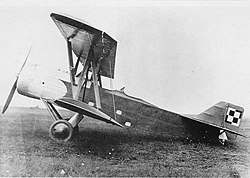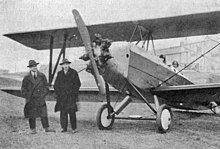Bartel BM-4
| Bartel BM-4 | |
|---|---|

|
|
| Type: | Trainer aircraft |
| Design country: | |
| Manufacturer: | |
| First flight: |
December 27, 1927 |
| Commissioning: |
1928 |
| Number of pieces: |
≈75 |
The Bartel BM-4 was a Polish trainer aircraft developed in the late 1920s . It was the first series-built in-house design of the "Wielkopolska Wytwórnia Samolotów" (WWS) in Poznań and at the same time the first type developed in its own country that was used by the Polish Air Force .
development
In 1927, in support of the domestic aviation industry, the Polish Ministry of Aviation initiated a program to create a beginner's training aircraft. One point of the claim involved the use of a Le-Rhone - rotary engine , by the still large in Poland, from the war period there were derived quantities. WWS chief designer Ryszard Bartel based the design on his BM-2 from 1926, but kept the aircraft smaller and lighter overall. The government approved the design and commissioned two prototypes . The first was equipped with a Czech Walter Vega engine with 85 hp and, after its maiden flight, was presented to Polish government representatives on December 20, 1927 as the BM-4b . They were satisfied, especially since the guy proved to be very sure of a spin . Then the construction of the second prototype began, but this time with a Polish 80 HP radial engine Avia WZ-7 as drive. The flight tests began on April 2, 1928 as the BM-4d and were also satisfactory. While the BM-4b was delivered to the Afghan royal family after the end of the test series , the BM-4d received the originally required engine from Le-Rhône at the end of April 1928 and thus served as the starting model for a series of 22 aircraft that were under the from May 1929 Designation BM-4a were transferred to the Polish Army. These aircraft were modified in 1930 and, in addition to rounded wing tips, modified ailerons and tail surfaces, received an axle-less landing gear with air-oil shock absorbers from Vickers . The second prototype was also equipped with the modified chassis and also received a newly developed local Peterlot star engine with 85 hp. This version, known as BM-4e , did not go into series production because the engine had not yet been adequately tested.
Some production aircraft were also tested with different drives. In 1931, for example, an SM-4a received a G-594 engine from Škoda with 120 hp as the SM-4f and a specimen called the SM-4g was tested with a British 100-hp Gipsy I in - line engine . Both models were later upgraded to the production standard.
In 1931, the Polish armed forces again reported a need for 50 training aircraft. Since the WWS had since been dissolved due to financial deficits, the order went to the Podlaskaer Flugzeugfabrik ( PWS ). It took over the modified chassis, lengthened the fuselage by 320 mm and improved the aerodynamics of the contour. A Walter Junior 4 star engine, which was tested in a BM-4a , served as the drive . These aircraft, designated BM-4h , were mainly used at the Air Force Central Flight School in Dęblin . After they were retired, many of them went to civil aviation clubs, but were taken over again by the army in 1939 after the start of the war and used for liaison tasks .
The BM-5 appeared in 1928 as a performance-enhanced and enlarged further development .
Technical specifications
| Parameter | Data (BM-4a) |
|---|---|
| crew | 2 |
| span | 10.17 m |
| length | 7.22 m |
| height | 2.93 m |
| Wing area | 25 m² |
| Empty mass | 538 kg |
| Takeoff mass | 791 kg |
| drive | an air-cooled nine-cylinder - rotary engine Le Rhone C with 80 hp (60 kW) |
| Top speed | 125 km / h near the ground |
| Service ceiling | 2820 m |
| Flight duration | 3 h |
literature
- Peter Alles-Fernandez (Ed.): Aircraft from A to Z. Volume 1: Aamsa Quail – Consolidated P2Y. Bernard & Graefe, Koblenz 1987, ISBN 3-7637-5904-2 , p. 172.
Web links
- Bartel BM-4 (BM-7), 1927. Retrieved January 22, 2020 (Polish).
